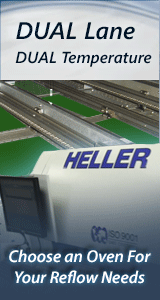Printed Circuit Board Assembly & PCB Design Forum
SMT electronics assembly manufacturing forum.
- SMTnet
- »
- Electronics Forum
- »
- Fiducials
Fiducials
![]()
![]() We are using .040" diameter fiducials (global and local) o...
- Feb 18, 1999
by
We are using .040" diameter fiducials (global and local) o...
- Feb 18, 1999
by
![]()
![]() The circle is not a "good" fiducial. The gradually change ...
- Feb 18, 1999
by
The circle is not a "good" fiducial. The gradually change ...
- Feb 18, 1999
by
![]()
![]() | We are using .040" diameter fiducials (global and local)...
- Feb 18, 1999
by
| We are using .040" diameter fiducials (global and local)...
- Feb 18, 1999
by
![]()
![]() | We are using .040" diameter fiducials (global and local)...
- Feb 19, 1999
by
| We are using .040" diameter fiducials (global and local)...
- Feb 19, 1999
by
![]()
![]() If the fiducials are rejected from the vision system, I wo...
- Feb 19, 1999
by
If the fiducials are rejected from the vision system, I wo...
- Feb 19, 1999
by
![]()
![]() Hi Bob,
I know what you're talking about, it seems...
- Feb 19, 1999
by
Hi Bob,
I know what you're talking about, it seems...
- Feb 19, 1999
by
![]()
![]() Hi Bob,
I know what you're talking about, it seems...
- Feb 19, 1999
by
Hi Bob,
I know what you're talking about, it seems...
- Feb 19, 1999
by
![]()
![]() You don't say what kind of machine you are using but sever...
- Feb 19, 1999
by
You don't say what kind of machine you are using but sever...
- Feb 19, 1999
by
![]()
![]() | We are using .040" diameter fiducials (global and local)...
- Feb 20, 1999
by
| We are using .040" diameter fiducials (global and local)...
- Feb 20, 1999
by
![]()
![]() We are currently using circle, cross and double-cross(#) f...
- Feb 22, 1999
by
We are currently using circle, cross and double-cross(#) f...
- Feb 22, 1999
by
![]()
![]() We have resorted to adding a ring (or donut) around our 0....
- Feb 22, 1999
by
We have resorted to adding a ring (or donut) around our 0....
- Feb 22, 1999
by
- SMTnet
- »
- Electronics Forum
- »
- Fiducials







